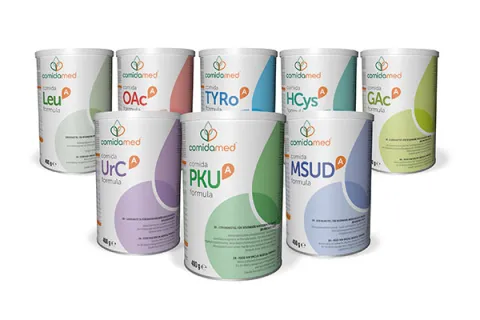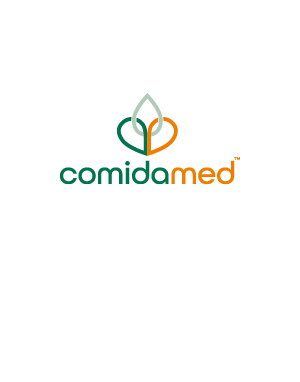A practical guide to the introduction and use of comida-HCys A formula
This practical guide is for the use of comida-HCys A formula in the dietary management of an infant with Homocystinuria.
- comida-HCys A formula must only be used under medical supervision.
- Suitable from birth to 12 months of age.
- Not suitable for use as a sole source of nutrition.
- comida-HCys A formula must only be consumed by infants with proven Homocystinuria.
- comida-HCys A formula must be used in conjunction with breast milk or infant formula to provide the methionine, fluid and general nutritional requirements of the infant in quantities as advised by a clinician or dietitian.
- For enteral use only.
The information contained in the practical guide is for general information purposes only and does not constitute medical advice.
The practical guide is not a substitute for medical advice or care provided by a licensed and qualified healthcare professional and Vitaflo does not, in the absence of negligence on Vitaflo’s part, accept any liability arising from reliance on information contained in this guide and or the incorrect use of comida-HCys A formula product.
This practical guide should be read in conjunction with local, national and international guidelines and best practice for the dietary management of Homocystinuria.
Information contained within the guide is based on the most recent scientific evidence available on the management of Homocystinuria as of date of publication.
This practical guide does not establish or specify particular standards of medical care for the treatment of any conditions referred to in this practical guide.
Vitaflo International Limited does not recommend or endorse any specific tests, procedures, opinions, clinicians or other information that may be included or referenced in this practical guide.
| Symbol | Abbreviation | Definition |
|---|---|---|
| HM | Human milk | |
| BF | Breastfeed | |
| HCP | Healthcare Professional | |
| MET | Methionine | |
| tHcy | Total homocysteine | |
| MET-free formula | MET-free formula (comida-HCys A formula) | |
| SIF | Standard infant formula | |
| CBS | Cystathionine beta-synthase |
1.0 Overview of feeding an infant with Homocystinuria (HCU).
1.1 Nutrition prescription using comida-HCys A formula at diagnosis.
1.3 Checklist for blood homocysteine and methionine monitoring.
1.4 Fine-tuning the nutrition prescription.
2.0 Practical feeding strategies to use with caregivers.
2.1 Practical points for effective communication between HCPs and caregivers.
3.0 References.
1.0 Overview of feeding an infant with HCU
Infants newly diagnosed with HCU are typically trialed on pyridoxine for two weeks, while on a standard diet to determine responsiveness. If an infant is deemed unresponsive or partially-responsive with total homocysteine (tHcy) levels above 50 μmol/L1, they are prescribed a methionine-free formula (comida-HCys A formula), indicated for infants, as medically appropriate pending the clinical status of the infant1.
Feeding an infant with HCU is a balance between providing methionine-free formula alongside adequate amounts of methionine from human milk (HM)/standard infant formula (SIF), with the goal of keeping methionine (MET) levels and homocysteine (tHcy) levels within target therapeutic ranges.
The goal range for methionine in patients on betaine is <1000 μmol/L. The goal ranges for tHcy are <100 μmol/L in nonpyridoxine responsive patients and <50 μmol/L in patients who are responsive1.
In HCU, cystathionine beta-synthase (CBS) is the deficient enzyme. In normal metabolism, this enzyme converts homocysteine to cysteine. Elevated homocysteine and MET occur when the body cannot convert excess homocysteine into cysetine. Homocysteine is the amino acid that is toxic to the body in HCU. Limiting MET in the diet limits homocysteine production as methionine is a precursor in the impaired pathway1.
Since MET is an essential amino acid (cannot be produced by the body, therefore dietary intake is required) the body requires a small amount for normal growth and development. This is provided though either HM or SIF as the source of MET.
A family should be supported to make the appropriate choice for their family and their infant, with relevant healthcare professionals’ input as appropriate.
comida-HCys A formula may be used, after confirmation of the HCU diagnosis and the following pyridoxine trial, in combination with HM/SIF.
Alternatively, it may be used as a sole source of nutrition for a brief period known as a “washout” for 2-4 days1 in order to achieve a rapid reduction in blood tHcy levels. This “washout” regimen should only be used by the metabolic healthcare provider, if diagnostic blood tHcy levels are found to be significantly elevated on laboratory results, or if there is concern for significant tHcy elevation. It is important that blood MET and tHcy levels are monitored very closely to prevent MET deficiency.
After this “washout” period, determined by the metabolic healthcare provider, a source of MET, either HM or SIF, is reintroduced and given in combination with comida-HCys A formula.
Breastfed Infants
Healthcare providers should support a family’s decision to BF or provide HM, as the MET / intact protein source for an infant with HCU, whenever possible. comida-HCys A formula combined with bottle-fed HM or feeding at the breast may be used to maintain satisfactory blood MET and tHcy control, provided there is adequate HM available for the infant and blood MET and tHcy levels can be closely monitored1-3.
Feeding at the breast may not always be possible with HCU. Families should discuss what is best for them and their infant with their metabolic healthcare provider.
HM offers nutritional benefits including higher long chain polyunsaturated fatty acid concentrations and a lower MET content. MET in HM is 21 mg/100 ml4 compared with approximately 30-35 mg/100 ml in SIF (values for SIF are taken from three common SIF available in the USA, retrieved October 2024).
Breastfeeding an infant with HCU is based on the principle of giving a measured volume of comida-HCys A formula to offset the infant’s appetite for breastfeeds.
Feeding a measured amount of comida-HCys A formula alongside each breastfeed, or alternating measured feeds of comida-HCys A formula with breastfeeds, decreases the total amount of HM consumed and therefore decreases total MET intake.
Infants can still feed on demand, varying the quantity of feeds from day to day provided that the prescribed quantity of comida-HCys A formula is given throughout the day3.
Successful HCU management with breastfeeding is achieved via close monitoring of blood MET and tHcy levels and adjustment of the prescribed volume of comida-HCys A formula by the managing metabolic healthcare professional in order to maintain blood MET and tHcy control.
In practice, we start by alternating between breastfeeding and formula feeding. We then adjust the amount of formula according to laboratory results and the rate of lactation.
SIF fed infant
There are various options for feeding an infant with SIF and comida-HCys A formula.
With the help of managing healthcare professional, families may choose a SIF supplemented with DHA and ARA that is best for their infant and family circumstances.
SIF and comida-HCys A formula may be given in separate or mixed bottles, depending on specific clinic protocol and preference, with a variety of feeding approaches capable of optimizing blood MET and tHcy control and catering to a family’s individual circumstances.
Blood MET and tHcy Level Monitoring
Blood MET and tHcy levels are used to determine whether the volume of comida-HCys A formula and HM/SIF should be adjusted; as discussed earlier, tHcy is the most dangerous metabolite in HCU, but MET deficiency must be avoided in order to promote normal growth and neurodevelopment.
Expect to adjust the feeding plan often, most likely weekly, especially during the first two months of life.
Blood MET and tHcy levels should be checked at least weekly throughout infancy1, 5.
The quantity of MET tolerated by infants will vary and be guided by blood MET and tHcy levels.
Individual MET tolerance will vary significantly throughout infancy with changes in growth and development. It is vital to investigate all the possible causes for changes in MET and tHcy levels before adjusting the feeding plan.
Consider waiting for two consecutive blood MET and tHcy levels to indicate the need for a feeding plan adjustment, unless the blood MET level is very low or blood tHcy very high.
Progression
A combination of HM/SIF and comida-HCys A formula may continue to provide 100% of the infant’s nutrition requirements until the age of 6 months, or when the infant is developmentally ready for the introduction of solids.
Complementary feeding should be supported by the metabolic healthcare provider.
Important Notice
Breastfeeding can continue for as long as the mother and infant wish, provided that growth, blood MET and blood tHcy levels are satisfactory.
SIF should be introduced if there is inadequate HM to provide enough MET or liquid nutrition volume for age, in combination with comida-HCys A formula.
If the mother wishes to wean the infant from HM, then a gradual approach is recommended, if possible.
Principles of initiating nutrition management
Monitor blood MET and tHcy levels weekly to achieve stability in blood MET and tHcy.
Guidelines recommend aiming for a MET treatment range of <1000 μmol/L and tHcy treatment range of <100 μmol/L in non-pyridoxine responsive infants or <50 μmol/L in pyridoxine responsive infants1, 5.
If tHcy levels > 50 μmol/L and if medically appropriate given clinical status after diagnosis and pyridoxine trial, comida-HCys A formula can be used to reduce tHcy levels rapidly.
Depending on diagnostic MET and tHcy levels and clinical circumstances, the metabolic team may consider the following strategies for initiating comida-HCys A formula:
- Temporarily stop HM/SIF and use comida-HCys A formula as sole nutrition source for 2-4 days1 as a “washout” to quickly decrease tHcy.
- Introduce comida-HCys A formula in combination with HM/SIF.
If a “washout” is pursued and if HM/SIF has been stopped, reintroduce MET to tolerance.
Intact protein intake is adjusted based on individual blood MET and tHcy levels.
For breastfed infants, comida-HCys A formula volumes will be adjusted with the intended effect of modifying the infant’s appetite for HM.
Continue to give a combination of comida-HCys A formula and HM/SIF to provide 100% of the infant’s requirements and to achieve optimal growth, MET and tHcy levels.
HM/SIF and comida-HCys A formula should provide 100% of the infants’ nutrition needs until approximately the age of 6 months when solids are introduced or when the infant is developmentally ready for the introduction of solids.
- comida-HCys A formula and MET source (HM/SIF) may be given together at each feed, or at alternating feeds to ensure nutrient availability throughout the day.
- If the prescribed volume of comida-HCys A formula is not taken, it may cause a rise in blood MET levels, leading to a rise in tHcy levels, which is very dangerous for the infant.
- Blood MET and tHcy levels are used to determine whether comida-HCys A formula, SIF/HM prescription should be adjusted.
- The infant should be weighed at each clinic visit or more frequently if there is a clinical concern.
1.1 Nutrition prescription using comida-HCys A formula at diagnosis after the pyridoxine trial
The aim is to achieve a rapid reduction in blood tHcy levels. Reducing MET intake will in-turn reduce tHcy levels.
If temporarily stopping intact protein and using comida-HCys A formula alone to lower very high blood MET levels, a two-step method is used:
Step 1 - Introduction of comida-HCys A formula
- Use comida-HCys A formula as a sole source of nutrition for 2-4 days as directed by the managing healthcare professional depending on the infant’s response to a trial of pyridoxine1.
- comida-HCys A formula should be offered on demand to the infant if medically appropriate to do so.
Feeding plan and considerations:
- Mix desired amount of comida-HCys A formula per feed (see example feeding plans which follow). A 3 to 4 week-old infant will typically take about 90-120 ml (3-4 fl oz) per feed.
- Encourage family to track number of wet and soiled diapers to ensure intake adequacy.
- Feeding frequency may need to be higher for infants who have not yet regained their birth weight.
- Family should consult with their managing healthcare professional.
- Encourage mothers breastfeeding to express breast milk when the infant feeds to establish and protect breast milk supply during the washout regimen.
- Maternal-infant skin-to-skin contact and/or a small number of short duration breastfeeds (if approved by metabolic healthcare provider), may be continued to help promote breast milk supply and bonding during the period when breastfeeding is stopped.
Step 2 - Reintroduction of HM/SIF
- In 2-4 days at the discretion of the managing healthcare professional.
- See example feeding plans below.
1.2 Example feeding plans
If a washout regimen is not required or reintroducing intact protein source, the following feeding plans illustrate 2 methods for calculating the feeding plan whether breastfeeding or bottle-feeding with expressed HM or SIF.
Also note, many factors can affect blood MET and tHcy levels. Always check for causes of high or low blood levels before making a change to the nutrition prescription.
Example using a 3-week-old infant diagnosed with HCU with insufficient reduction of tHcy following a pyridoxine trial, therefore requiring dietary restriction of MET, weight 4,2 kg.
If breastfeeding
As we don’t know how much human milk is consumed, start by adding in one feed of comida-HCys A formula from a bottle and feeding at the breast with other feeds.
Let the infant take as much as they want at each feed.
Parents should keep a meal/feed diary, noting the time of each meal (breastfeeding or bottle-feeding) and the precise amount consumed when comida-HCys A formula milk is given.
If maternal milk is given by bottle feed
Estimate amount of HM needed for a 4,2 kg infant, consider: (*calculations in brackets)
- MET requirements for 0-6 months = 15-60 mg/kg/day5, using an assumed average tolerance 25 mg/kg/day (25 x 4,2 = 105 mg/day) = 105 mg MET/day
- HM = 21 mg MET/100 ml (105/21 x 100 = 500 ml HM) = 500 ml HM/day.
Using precise feeding volumes |
|
|
comida-HCys A formula & BF |
comida-HCys A formula & expressed HM/SIF |
|
Estimate total volume intake per day using 150 ml/kg6 x 4,2 kg = 630 ml/day |
|
|
Estimated MET need = 15-60 mg MET/kg/day5. Using 25 mg MET/kg/day = 105 mg |
|
| Estimate amount of HM needed: ~500 ml HM (21 mg MET/100 ml4) HM will not actually be measured but this estimate gives a place to start. |
Estimate amount of HM/SIF needed: ~500 ml HM (21 mg MET/100 ml4) ~300 ml SIF (35 mg MET/100 ml) |
|
Estimate amount of comida-HCys A formula needed to meet remaining fluid needs. |
|
| 630 ml total volume – 500 ml HM = 130 ml comida-HCys A formula per day. | 630 ml total volume – 500 ml HM = 130 ml comida-HCys A formula per day. 630 ml total volume – 300 ml SIF = 330 ml comida-HCys A formula per day. |
|
Divide total amount of estimated comida-HCys A formula needed by number of feeds per day.
OR Alternate between the following feeds:
|
Establish mixing prescription per bottle by dividing HM/SIF and comida-HCys A formula needed per bottle*.
|
|
As a starting point, try to simplify the above plans into more easily measurable quantities such as: |
|
|
20 ml comida-HCys A formula prior to each BF OR Alternate between the following feeds:
|
Adjust amounts accordingly to make easily measurable amounts to make a total 60 ml (2 fl oz) bottles if metabolic dietitian feels comfortable allowing the change in MET prescription. |
* Infants should be fed to appetite when hungry and total liquid volume per day should not be limited to establish MET and tHcy level control. If the estimated volume intake does not satisfy the infant, then additional feeds either of comida-HCys A formula alone or mixed comida-HCys A formula + HM/SIF may be given depending on what is clinically appropriate.
1.3 Check list for blood MET and tHcy monitoring
Many factors can affect blood MET and tHcy levels. Always check for causes of high or low blood MET level or high tHcy before making a change to the nutrition prescription.
Considerations for high blood MET or tHcy levels
Possible cause |
Action |
|---|---|
Excess intake of intact protein (HM/SIF) |
|
Inadequate intake of comida-HCys A formula |
|
Catabolism or slow weight gain |
|
Change in blood monitoring routine |
Encourage consistent timing of blood MET and tHcy level within family’s and infant’s specific circumstances. |
Betaine usage |
Betaine remethylates homocysteine into methionine which results in reduced homocysteine but an increase in MET. Confirm medication changes in line with lab results if MET is higher than expected given tHcy. |
Considerations for low blood MET levels
Possible cause |
Action |
|---|---|
Inadequate intake of intact protein (HM/SIF) or Excessive intake of comida-HCys A formula |
|
Anabolism or rapid growth phase |
|
Change in blood monitoring routine |
Encourage consistent timing of blood MET and tHcy level over the day within family’s and infant’s specific circumstances. |
Monitoring tips
For all infants, frequent monitoring of MET and tHcy levels is key, but try not to make changes to a feeding plan too frequently.
Consider:
Many factors affect MET and tHcy levels; review all causes in this section.
- Monitor MET and tHcy level trends
Unless MET level is very low or very high or tHcy is very high, consider:- Continuation of the current plan
- Awaiting 2 consecutive MET and tHcy levels before adjusting prescription
- In general, do not make more than 1 change to the plan in 1 week
For MET levels that ARE very low or very high:
- Consider repeating blood MET level sooner than 1 week to guide interventions or other intervention as recommended by metabolic healthcare professional.
Remember:
Sick day protocols are not addressed in this guide because guidelines for incurrent illness in HCU recommend continuing the infant’s standard treatment regimen, whilst avoiding dehydration and immobilization1. Seek advice from healthcare professionals as needed.
1.4 Fine-tuning the nutrition prescription
For a breastfed infant + comida-HCys A formula |
|
|
Action |
|
| If blood MET and tHcy is HIGH after 2 consecutive samples or after a single, very high level | If blood MET is LOW after 2 consecutive samples or after a single, very low level |
|
|
|
EXAMPLE: infant weight 5 kg |
|
|
Current feeding regimen |
|
|
30 ml (1 fl oz) comida-HCys A formula prior to every breastfeed. |
|
|
Adjustment |
|
|
35 ml (1,2 fl oz) comida-HCys A formula prior to every breastfeed (~15% increase). OR Alternate between the following feeds:
|
25 ml (0,85 fl oz) comida-HCys A formula prior to every breastfeed (15% decrease). OR Alternate between the following feeds:
|
For a bottle-fed infant + comida-HCys A formula |
|
|
Action |
|
| If blood MET and tHcy is HIGH after 2 consecutive samples or after a single, very high level | If blood MET is LOW after 2 consecutive samples or after a single, very low level |
|
|
|
EXAMPLE: infant weight 5 kg |
|
|
Current feeding regimen |
|
|
Adjustment |
|
|
35 ml (1.2 fl oz) comida-HCys A formula + 55 ml (1,8 fl oz) SIF. Estimated comida-HCys A formula per day = 280 ml (9,3 fl oz). |
25 ml comida-HCys A formula + 65 ml SIF. OR Give 6 bottles of 90 ml SIF alternated with 2 bottles of 100 ml comida-HCys A formula spaced evenly throughout the feeds (example: 3 bottles of SIF, 1 bottle of comida-HCys A formula, followed by 3 bottles of SIF, and then the last bottle of comida-HCys A formula). |
If the infant is still hungry after the feed, there are different approaches that may be used to achieve satiety for the infant while maintaining blood MET and tHcy control (infants should always be fed to appetite, and total feeding volume should not be restricted to achieve MET and tHcy level control):
1) Offer additional comida-HCys A formula to achieve satiety.
2) Offer additional mixed bottle of SIF/HM + comida-HCys A formula where clinically appropriate to achieve satiety.
2.0 Practical feeding strategies to use with caregivers
Be prepared with feeding supplies. It is important for HCPs to know what supplies the family/caregivers have on-hand and to ensure they can get proper supplies when needed.
These include:
Feeding bottles with necessary measurement markings (demarcation) for infant’s recipe
- Appropriately staged nipples for infant feeding
- Adequate supply of comida-HCys A formula
- HM pump and supplies if needed to express
- Adequate supply of SIF (if using)
Formula mixing instructions
- Use comida-HCys A formula scoop (or gram scale) to mix comida-HCys A formula. Do not use scoops from other formula containers to mix comida-HCys A formula
- Ensure family has access to a safe water source for formula mixing
- Inquire about the most effective written method for family to receive new recipes and mixing instructions. Review mixing at every visit
Confirm family/caregivers are able to procure more comida-HCys A formula and SIF (if using) when supplies are low. Consider providing written guidance on where families can obtain these formulas. Direct families to appropriate agencies and services if needed to obtain SIF at low-cost or for free.
2.1 Practical points for effective communication between HCPs and caregivers
Establish lines of communication between HCP and caregiver/family
Phone calls, e-mail, text and/or the medical record portal may all be used. Ensure caregivers/families are comfortable using communication method.
Keep information simple and practical and check family/caregiver understanding
Allow time for questions and encourage questions between visits.
Consider written feeding plans.
Encourage questions
Caregivers should be encouraged to ask questions and speak up whenever they do not understand. Effective and open lines of communication as well as appropriate teaching methods are critical for caregiver success.
Educate all caregivers
Let primary caregiver(s) know that anyone taking care of the infant is welcome at clinic visits and education pieces may be provided for all caregivers depending on their needs.
Establish frequency of reviewing MET and tHcy levels and clinic visits
Ensure caregivers understand what communication method will be used to report results and adjust the diet between visit.
Inform other HCPs, including the primary care physician, of the management plan
Direct caregivers to appropriate patient/family support groups and appropriate information platforms
Remember that different patients/families succeed with different communication methods
Be as adaptable as you can within your clinic’s capabilities.
3.0 References
- Morris AA, Kožich V, Santra S, et al. Guidelines for the diagnosis and management of cystathionine beta-synthase deficiency. J Inherit Metab Dis. 2017;40(1):49-74. doi:10.1007/s10545-016-9979-0.
- Huner G, Baykal T, Demir F, Demirkol M. Breastfeeding experience in inborn errors of metabolism other than phenylketonuria. J Inherit Metab Dis. 2004; 28(4):457-465. Available from: doi:10.1007/s10545-005-0457-3.
- MacDonald A, Depondt E, Evans S, et al. Breast feeding in IMD. J Inherit Metab Dis. 2006;29(2-3):299-303. doi:10.1007/s10545-006-0332-x.
- Food data Central Search Results. FoodData Central. Accessed October 13, 2024. https://fdc.nal.usda.gov/food-details/171279/nutrients
- Roberts A-M. Nutrition Management of Homocystinuria and Cobalamin Disorders. In: Bernstein, LE, Rohr, F, van Calcar, S. Nutrition Management of Inherited Metabolic Diseases. Springer International Publishing ; 2022:212-224.
- Shaw V, McCarthy H. Principles of Paediatric Dietetics: Nutritional Assessment, Dietary Requirements and feed Supplementation. In: Shaw V, editor. Clinical paediatric Dietetics. 5th ed: Wiley Blackwell; 2020.
Download this practical guide
If you'd like to print or refer to this practical guide offline, download it for your reference in the future.
Browse other topics
Discover more from the comidamed world:



